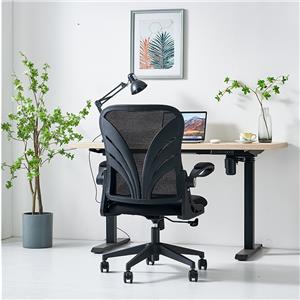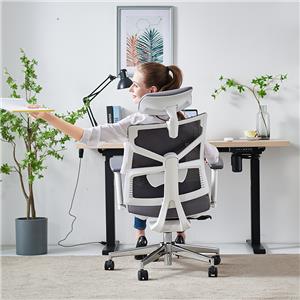"Ergonomics" of armchairs
As the saying goes, "sitting for a long time hurts the body".
Migrant workers have to sit in front of the computer for at least eight hours a day. When they get off work, their backs are sore and they feel that their whole body is not their own.
At this time, many people set their sights on modern ergonomic chairs. As everyone knows, the ancients have long designed ergonomic chairs.
Ergonomics, also known as "ergonomics", "ergonomics" and "human factors engineering", is a new discipline emerging in European and American countries in the early 20th century. The purpose of maintaining healthy and efficient operation. In the field of furniture design, ergonomics is mainly used to determine the shape, scale and scope of use of furniture.
Chairs and stools are furniture that are in direct contact with the human body for the longest time except beds. A seat with reasonable ergonomic indicators can reduce the burden on leg muscles, reduce human energy consumption, make blood flow smoothly, and prevent bone deformation.
As early as the Ming Dynasty, ancient Chinese literati and craftsmen had naturally met the ergonomic requirements of modern furniture design in terms of the design proportions, scales, structures, and many details of armchairs.
As a classic piece of Ming-style furniture, the armchair not only has high artistic value, but also its design, whether in shape or material selection, is very ergonomic and can relax every part of the body. .
The Ming-style armchair developed from the top chair, developed through the Tang and Song Dynasties to the Ming Dynasty, with a generous and natural shape, elegant and simple, and a round outside and a square inside. The name of the armchair is derived from the round back which is shaped like a circle. Its most obvious feature is that the back of the armchair is connected to the armrest, and it goes down slowly. When sitting, people's shoulders and back can lean on the armrest of the armchair, which is very comfortable.
Combined with the existing ergonomic research, the ergonomic design of armchairs should be reflected in at least three aspects: the height, width, and depth of the seat, and the material of the seat surface; the curvature, inclination, and curved edge of the backrest; the armrest height, width, length.
Ergonomics of the chair surface:
The ergonomics of the armchair seat surface is usually considered from these angles: seat width, seat depth, seat height, and seat surface material.
The seat width of an ergonomic work chair should not be less than 46cm, but it should not be too large. Refer to the armchairs listed by Mr. Wang Shixiang in "Appreciation of Ming-style Furniture". The minimum seat width is 54.5cm and the maximum is 63cm, far exceeding the seat width requirements of work chairs, and even reaching the seat width standard of a single sofa ( Not less than 60cm), the design size of the seat width of the armchair is more reasonable.
Looking at the seat height, if the seat surface is too low or too high, the human body will experience corresponding discomfort after a long time. The seat surface is too low, the body usually leans forward, and the back bones become "C" shape due to stretching, causing waist discomfort. The seat surface is too high, the feet cannot touch the ground, and the pressure on the legs will cause muscle soreness and numbness.
The index of seat height generally refers to calf + foot height + shoe height. According to the 50th percentile data of calf + foot height in the national standard GB10000-88 of Chinese adult human body size in 1988 (female: 38.2cm, male: 41.3cm), In addition to the shoe height of ordinary sports shoes of 3~5cm, armchairs with a seat height of about 45cm can also meet this requirement.
Even the armchairs with a slightly higher seat height will be equipped with mud or tube foot rests, and even be supplemented with foot-supporting and blood-activating rolling stools to make people's legs feel comfortable.
For ergonomic chairs, the seat depth is mostly set to 40cm-44cm, and the adjustment is 5cm. The seat depth of armchairs is generally 43~50cm, which is basically consistent with the requirements of ergonomic chairs. When the buttocks fit the backrest, the thighs and legs can hang down naturally.
The last is the choice of seat material. The armchairs are all made of framed panels, and there are hard drawers and soft drawers.
Hard drawers generally use hardwood plain panels, such as red sandalwood, huanghuali, mahogany, etc., which are beneficial to people's physical and mental health. Rosewood is beneficial to the functions of the human heart, liver and kidneys, and its light aroma has a refreshing effect. Huanghuali wood contains tree essential oils, which can relax the meridians, activate blood circulation, calm the nerves and calm the mind. Mahogany is also able to calm the mind and calm the mind, promote Qi and relieve depression.
The soft drawer is generally made of woven material with upper rattan and lower brown, which is breathable and elastic, and has better comfort. It is closer to the composite woven material used in modern ergonomic chairs. It fits the buttocks to a greater extent, with low economic cost and easy replacement. .
Ergonomics of the backrest:
After the middle and late Tang Dynasty, the sitting posture of the ancients gradually changed from sitting on the ground to sitting with feet hanging down. The thighs and legs hang naturally at 90° and can move freely, but the upper body is still straight and tense. Until the Song and Ming Dynasties, chairs with backrests and armchairs emerged and became popular, allowing the muscles of the upper part of the body to relax and provide proper support.
The standard shape of the armchair has an S-shaped backrest, which is tilted backwards by 95°~105°, and the movement of the chair almost coincides with the human spine. When people rest on their backs, they can get moderate relaxation but not fall into a state of deep relaxation. The recommended inclination angle of the backrest of modern ergonomic chairs is generally 105°~120°, and the inclination angle of the backrest of the non-standard armchair used for leisure can even reach more than 120°, which requires a more relaxed posture and allows a certain degree of leaning back rest.
From the perspective of the backrest curve, most of the backboard of the armchair has three bends and is S-shaped. , and provide a certain amount of support for the back muscles.
The curved edge of the backrest requires very fine seat indicators, even for modern ergonomic chairs, some manufacturers have not applied this part of the data. In the production of ancient Chinese chair furniture, only a few chairs represented by Ming-style armchairs took this into consideration.
The curved edge index mainly requires the chair to fit the position of the third vertebra of the human body, and according to the curve of the spine, it is just right to support the third vertebra and the above parts at the bulge at the lower end of the "S" shape of the backrest. Modern ergonomics measures the vertical distance between the flange of the backrest and the seat surface in a standard sitting posture of 23~26 cm, and the flange of the backrest of the Ming-style armchair is about 24cm, which completely conforms to the scale of modern ergonomics and will be smoothed at the flange , to adapt to the height of the backrest flange of different human body.
From the perspective of ergonomics, the curvature, inclination, and curved edge of the backrest of the Ming-style armchair can provide strong support for the scapula and waist, and effectively relieve the fatigue of the back.
Ergonomics of the armrest:
The armrest function of the armchair is mainly to support the upper limbs. If the armrest is too high, it will cause tension in the muscles above the shoulders; if the armrest is too low, it will not be able to provide support. The national standard GB10000-1988 for human body size of Chinese adults at the 50th percentile value of elbow height in sitting posture is 25~26cm for men and women, and the distance from the armrest to the seat surface of an armchair is about 25cm, which is basically in line with ergonomic standards.
The ergonomic armrest width is generally set to be greater than or equal to the width of the lower arm. Judging from the shape of the armrest of the armchair, it obviously does not meet this requirement. The armrest adopts a narrow curved shape, and the width of the upper part of the armrest cannot stably support the lower arm. In order to stabilize this structure, the craftsmen of the Ming Dynasty built goose necks and gang sticks to share part of the support. The main thing to stabilize the arm was the handle at the front end of the armrest. s reason.
The ergonomic index requirements for the depth of the armrest should generally not exceed the depth of the seat. The armrest depth of modern work chairs is roughly 2/3 of the seat depth, which is convenient for getting up to the left and right to get materials. For the harmony of the overall shape of the armrest, the length of the armrest is designed to be equal to the depth of the seat. On the one hand, it has a more balanced and harmonious aesthetic feeling; Hanging down, when the upper and lower arms are bent to 90°, they can just rest on the front of the armrest, so as to obtain stability.
At the beginning of the last century, the simple and reasonable ergonomic features of Ming-style armchairs were favored by Western designers. Hans Wagner, the evergreen tree of the Navian design school, drew on the simple and smooth lines of the armchair, the pure proportions, the ergonomic design of the backrest and seat surface, and designed the first Ming-style armchair in 1944. The representative "Chinese chair" was further modified and designed in 1950 to design the "Y" chair, which achieved great success at home and abroad, became popular all over the world, and has been passed down to this day.
It is not difficult to find that in recent years, the "new" design concept "ergonomics" highly praised by the design community has actually been applied by the ancients' advanced creation wisdom design as early as the Ming Dynasty. Although the design techniques and technologies of the ancients are very different from the current technology, there is a kind of parallelism beyond time and space in the design thinking.
Compared with today's popular ergonomic chairs, Ming-style armchairs are more suitable for the waist.




